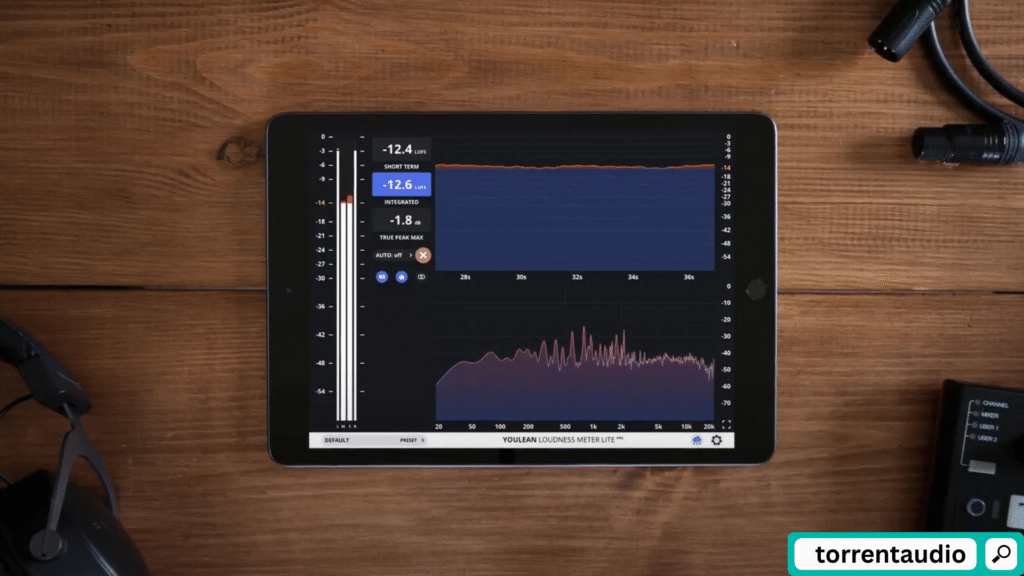
Youlean actual peak, and general dynamics in your mixes and masters is the Youlean Loudness Meter Ultra for Windows. It lets you meet the precise objectives without guesswork, whether you are preparing a single for streaming services, providing a podcast episode, or turning around stems for movies and television. Integrated, Short-Term, and Momentary LUFS are displayed by clear meters, and inter-sample clipping is controlled by a sensitive True Peak readout. You may quickly identify over-compressed or unbalanced scenes by looking at a history graph that shows how loudness changes across your whole timeline. It functions as a dependable “last check” before delivery, loading as a plugin in your DAW and (in the majority of builds) as a small standalone application for speedy file examination.
Feature Highlights:
- Complete loudness suite: True Peak and loudness range (LRA), along with integrated, short-term, and momentary LUFS, so you can safely match broadcast standards and platform specifications.
- Target presets: Even with short eyes, you can quickly tune in levels with these pre-made targets for sought-after transmission services, podcasting, gaming, and broadcasting.
- History and dynamics: A dynamics display (crest factor), peak trace, and scrollable loudness history show how processing affects punch and clarity over time.
- Resizable UI: It runs well on a laptop or a 4K screen thanks to its clear, resizable interface that includes zoom controls and scalable text.
- A/B and pictures: To test out various limiting or gain-staging techniques, save and compare states, then choose the one that best protects transients.
- Reports that may be exported: Take screenshots or export graphs for internal documentation, QC reports, or client comments.
- Broad format support: Available in standard plugin formats for Windows DAWs, plus a standalone analyzer for rapid drop-in testing.
What’s New 2025:
The 2025 version prioritizes stabilizer, quickness, and “fewer clicks to perform.” Faster scanning and more precise peak management during busy sessions—especially when managing multichannel or hour-long timelines—are the headline advantages you will see right away. Improvements to the quality of life of file-based processes include improved file summaries, sharper exported graphs for presentation, and more intelligent channel mapping on drag-and-drop. The tighter host interaction, better preset management, and responsive UI scaling that maintains meters buttery smooth even when zoomed in are all advantages for DAW users. Under the hood, the meter’s gating and integration logic has been adjusted to provide consistent Integrated LUFS on repeat passes—exactly what you want for compliance—while engine improvements lessen CPU spikes on dense masters.
Quick Guide:
- Put the meter in: In order for it to “see” the last signal you are sending, put it last on your master bus (after the limiter). Incorporate it into the appropriate subgroup for discourse or stem work.
- Select a target: Select a preset (such as a broadcast specification or streaming target) that corresponds to your destination. You can follow the meter lines and signs to ensure compliance.
- Run the entire program: Allow the meter to compute Integrated LUFS by running your whole track or timeline. Keep an eye on Momentary for quick peaks and Short-Term for section-by-section adjustments.
- Keep in mind True Peak: To avoid inter-sample clipping, reduce your limiter ceiling or modify your oversampling if True Peak rises over the suggested threshold.
- Verify the dynamics/crest factor view to balance the dynamics. Check the final limiter or bus compression if it is collapsing. Maintain dialogue’s consonants and drum transients.
- Remeasure after adjusting the limiter threshold, mix balance, or gain staging. To compare versions objectively, save A/B snapshots.
- Document: To show clients and partners how the loudness operates from beginning to end, export a graph or take a picture.
System Requirements:
- OS: Windows 7 or later
- Firefox formats: Common Windows formats like VST2/VST3 and AAX (readiness depends on your installer build)
- Host: consonant with significant Windows DAWs, including FL Studio, Ableton Live, Cubase, Studio One, Reaper, Pro Tools, and others
- Hardware: The meter can be handled by any present CPU and GPU that can comfortably run your DAW; allot a small amount of elevation for smooth UI provisioning on high-tenacity displays.
Tip: For finalization, run your limiter with modest oversampling and leave a little True Peak headroom. The meter will immediately reflect the improvement.
Download Steps:
- Select the appropriate edition: Choose between the basic metering tools and more sophisticated capabilities like snapshots and expanded outputs.
- Get the Windows installation here: Before continuing, check the file name and size after saving the installation to a local disk.
- Launch the installer: Choose your preferred plugin formats (VST3, AAX, etc.) and, if available, the standalone analyzer during setup. Verify that the default plugin paths correspond to the scan locations in your DAW.
- Unmount in your DAW: To ensure the new meters are indexed, open the plugin management in your DAW and run a rescan.
- If necessary, activate by launching the plugin, navigating to the activation page, and inputting your license code or payment information. If asked, restart the DAW.
- Try out a session: To make sure Integrated LUFS, True Peak, and history are operating as intended, insert the meter on a known project, load a target preset, and perform playback from beginning to finish.

